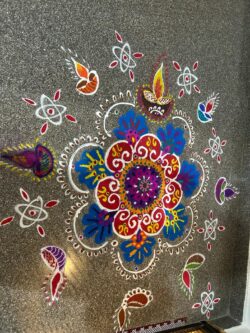
****This marvelous piece is an effort of my sister-in-law(Sailaja) who has an excellent hand in creating beautiful designs in Rangolis. In January she looks forward to exhibit her master pieces!
Unraveling the Hidden Algebra in Traditional Rangoli:
A Tribute to Our Ancestors’ Mathematical Mastery
Introduction:
Rangoli, a vibrant and intricate art form, has been an integral part of Indian culture for centuries. Created using colorful powders, flowers, or rice grains, rangoli designs adorn the thresholds of homes and public spaces during festive occasions. While rangoli is often appreciated for its aesthetic appeal, there is a fascinating connection between this traditional art and the principles of algebra. Delving into the history and symbolism of rangoli, we discover the mathematical genius of our ancestors, who ingeniously embedded algebraic concepts within these beautiful patterns.
The Mathematical Essence of Rangoli:
At first glance, rangoli may seem like an arrangement of dots, lines, and curves, but beneath its visual splendor lies a hidden world of mathematical precision. The dots, known as “bindu” in Sanskrit, serve as the foundation for building intricate designs. Each dot is assigned a numerical value, and the strategic placement of these dots forms the basis for algebraic calculations.
The Magic of Symmetry:
Symmetry is a fundamental principle in both mathematics and rangoli. Our ancestors understood the power of symmetry, as it represents balance and harmony. By incorporating symmetrical elements in rangoli, they not only created visually appealing designs but also employed algebraic concepts. Symmetry allows for the replication of patterns, enabling mathematicians to explore geometric transformations and equations.
The Role of Algebraic Expressions:
Algebra, the branch of mathematics that deals with equations and symbols, found its way into rangoli through the use of algebraic expressions. Our ancestors used these expressions to calculate the placement and connectivity of dots, lines, and curves. By manipulating variables and constants, they could create intricate designs that adhered to specific rules and formulas. This integration of algebraic thinking elevated rangoli from a mere art form to a testament of mathematical prowess.
Patterns and Sequences:
Rangoli patterns often consist of repetitive elements, forming sequences that follow certain rules. These sequences can be seen as mathematical progressions, where each element is derived from the previous one. Our ancestors skillfully employed arithmetic and geometric progressions to create balanced and visually appealing designs. Such patterns not only showcased their mathematical acumen but also added an element of rhythm and harmony to the artwork.
Conclusion:
Traditional rangoli, with its mesmerizing beauty and intricate designs, holds within it a rich mathematical heritage. Through the integration of algebraic principles, our ancestors demonstrated their mastery of mathematics and their ability to fuse art with science. The hidden algebra in rangoli serves as a reminder of the intellectual legacy passed down to us, urging us to recognize and appreciate the mathematical genius of our forefathers. As we continue to celebrate and preserve the art of rangoli, let us also honor the mathematical brilliance that lies at its core, paying tribute to the enduring legacy of our ancestors.
